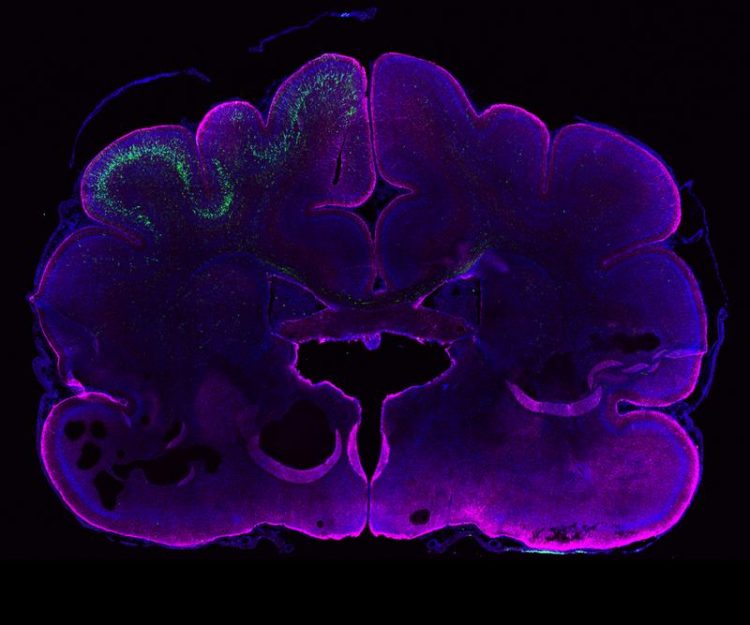Building a bigger brain

The picture shows the developing ferret brain. Magenta marks glial cells and clearly shows the outer contour of the brain. The green area consists of neurons that contain ARHGAP11B. Kalebic / Gilardi / MPI-CBG
The human brain owes its characteristic wrinkled appearance to its outer layer, the cerebral cortex. During human evolution, the neocortex, the evolutionarily youngest part of the cerebral cortex, expanded dramatically and had to fold into wrinkles to fit inside the restricted space of the skull.
The human neocortex supports advanced cognitive skills such as reasoning and language. But how did the human neocortex become so big? The answer may lie in genes that are unique to humans, such as ARHGAP11B. Researchers at the Max Planck Institute of Molecular Cell Biology and Genetics (MPI-CBG) in Dresden found that this human-specific gene, when introduced into the developing brain of ferrets, can cause an enlargement of their neocortex.
ARHGAP11B causes neural progenitor cells, which are cells that produce neurons, to make more of themselves for a longer period of time. The result is an expanded neocortex. The researchers published their findings in the journal eLife.
The human neocortex is roughly three times bigger than that of our closest relatives, the chimpanzees, and is the seat of many of the higher cognitive functions that are unique to humans, such as our speech or the ability to learn. A key question for scientists is how in human evolution the neocortex became so big.
In a 2015 study, the team around Wieland Huttner, research group leader at the MPI-CBG, found that under the influence of the human-specific gene ARHGAP11B, mice produced much more neural progenitor cells and could even undergo folding of their normally unfolded neocortex. The results suggested that the gene ARHGAP11B plays a key role in the evolutionary expansion of the human neocortex.
There are two types of neural progenitors in the mammalian neocortex: apical and basal. A subtype of the latter, called basal radial glial cells, are driving neocortex growth in human development. Unfortunately, mice have very few of them, which makes mice unsuitable to test whether the human-specific gene ARHGAP11B – via its effects on basal radial glial cells – can indeed cause an enlargement of the neocortex.
A team of researchers from the research group of Wieland Huttner now investigated what ARHGAP11B would bring about in a ferret brain. Ferrets have a larger neocortex than mice and possess more basal radial glial cells. The first author of the study, Nereo Kalebic, explains what he was able to observe:
“In ferrets, ARHGAP11B noticeably increased the number of basal radial glial cells. It also extended the time window during which the basal radial glial cells produced neurons. As a result, these ferret brains contained more neurons and thus had a bigger neocortex.” These results suggest that ARHGAP11B may have a similar role in the developing human brain. This study also provides the first evidence of a human-specific gene increasing the number of basal radial glial cells in a folded neocortex.
Wieland Huttner, who supervised the study, gives an outlook: “Further experiments need to be done to determine whether the ferrets with a larger neocortex also have enhanced cognitive abilities. If they do, testing these animals may provide insights into human cognition.”
Wieland Huttner
+49 (0) 351 210 1500
huttner@mpi-cbg.de
Nereo Kalebic
+49 (0) 351 210 2516
kalebic@mpi-cbg.de
Nereo Kalebic, Carlotta Gilardi, Mareike Albert, Takashi Namba, Katherine R Long, Milos Kostic, Barbara Langen, Wieland B Huttner: “Human-specific ARHGAP11B induces hallmarks of neocortical expansion in developing ferret neocortex” eLife, 28. November, 2018.
Media Contact
More Information:
https://www.mpi-cbg.de/de/home/All latest news from the category: Life Sciences and Chemistry
Articles and reports from the Life Sciences and chemistry area deal with applied and basic research into modern biology, chemistry and human medicine.
Valuable information can be found on a range of life sciences fields including bacteriology, biochemistry, bionics, bioinformatics, biophysics, biotechnology, genetics, geobotany, human biology, marine biology, microbiology, molecular biology, cellular biology, zoology, bioinorganic chemistry, microchemistry and environmental chemistry.
Newest articles

First-of-its-kind study uses remote sensing to monitor plastic debris in rivers and lakes
Remote sensing creates a cost-effective solution to monitoring plastic pollution. A first-of-its-kind study from researchers at the University of Minnesota Twin Cities shows how remote sensing can help monitor and…

Laser-based artificial neuron mimics nerve cell functions at lightning speed
With a processing speed a billion times faster than nature, chip-based laser neuron could help advance AI tasks such as pattern recognition and sequence prediction. Researchers have developed a laser-based…

Optimising the processing of plastic waste
Just one look in the yellow bin reveals a colourful jumble of different types of plastic. However, the purer and more uniform plastic waste is, the easier it is to…



